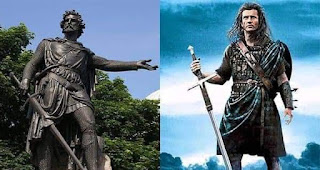Wallace was taken from the hall to the Tower of London, then stripped naked and dragged through the city at the heels of a horse to the Elms at Smithfield.
Wallace was transported to London, lodged in the house of William de Leyrer, then taken to Westminster Hall, where he was tried for treason and for atrocities against civilians in war, "sparing neither age nor sex, monk nor nun." He was crowned with a garland of oak to suggest he was the king of outlaws. He responded to the treason charge, "I could not be a traitor to Edward, for I was never his subject."
Following the trial, on 23 August 1305, Wallace was taken from the hall to the Tower of London, then stripped naked and dragged through the city at the heels of a horse to the Elms at Smithfield.
He was hanged, drawn and quartered—strangled by hanging, but released while he was still alive, emasculated, eviscerated and his bowels burned before him, beheaded, then cut into four parts.
His preserved head (dipped in tar) was placed on a pike atop London Bridge. It was later joined by the heads of the brothers, John and Simon Fraser. His limbs were displayed, separately, in Newcastle, Berwick, Stirling and Perth. A plaque unveiled 8 April 1956, stands in a wall of St. Bartholomew's Hospital near the site of Wallace's execution at Smithfield. It includes in Latin the words "Dico tibi verum libertas optima rerum nunquam servili sub nexu vivito fili" (I tell you the truth. Freedom is what is best. Sons, never live life like slaves.), and in Gaelic "Bas Agus Buaidh" (Death and Victory), an old Scottish battle cry.
In 1869 the Wallace Monument was erected, very close to the site of his victory at Stirling Bridge. The Wallace Sword, which supposedly belonged to Wallace, although some parts were made at least 160 years later, was held for many years in Dumbarton Castle and is now in the Wallace Monument.
Source~ Wikipedia











Comments
Post a Comment